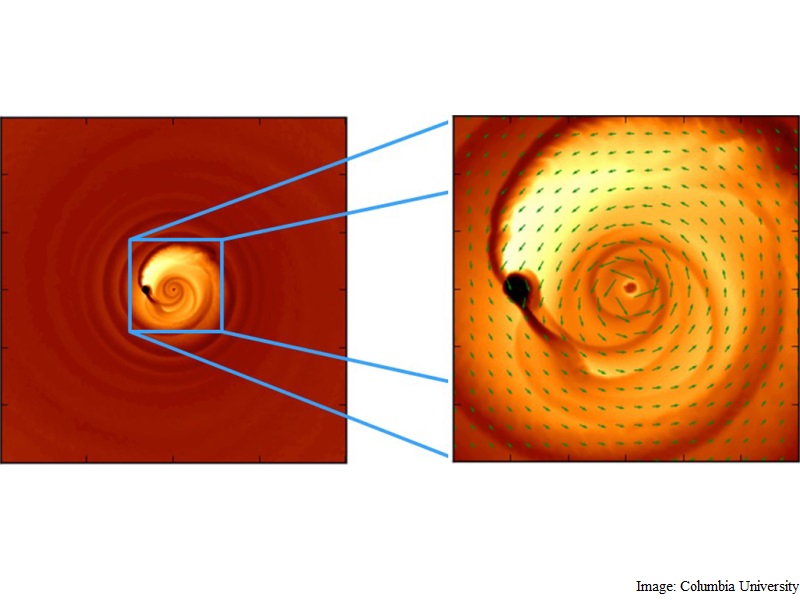- Home
- Science
- Science News
- 'Funky Light Signal' From Colliding Black Holes Explained
'Funky Light Signal' From Colliding Black Holes Explained

Entangled by gravity and destined to merge, two candidate black holes in a distant galaxy are expected to collide and merge in less than a million years, triggering a titanic blast with the power of 100 million supernovae.
The candidate black hole duo, called PG 1302-102, was first identified earlier this year using ground-based telescopes.
The black holes are the tightest orbiting pair detected so far, with a separation not much bigger than the diameter of our solar system.
"We were lucky to have GALEX data to look through. We went back into the GALEX archives and found that the object just happened to have been observed six times," said study co-author David Schiminovich from Columbia University in New York.
Researchers are studying this pair to better understand how galaxies and the monstrous black holes at their cores merge - a common occurrence in the early universe.
PG 1302-102 was discovered and reported earlier this year by researchers at the California Institute of Technology in Pasadena.
The researchers demonstrated that the varying signal is likely generated by the motion of two black holes, which swing around each other every five years.
In the new study published in the journal Nature, researchers found more evidence to support and confirm the close-knit dance of these black holes.
As one black hole orbits around its partner every five years, its light changes and appears to brighten as it heads toward us.
"It is as if a 60-Watt light bulb suddenly appears to be 100 Watts. As the black hole light speeds away from us, it appears as a dimmer 20-Watt bulb," explained Daniel D'Orazio, lead author from Columbia University.
The results will also help researchers understand how to find even closer-knit merging black holes in the future, what some consider the holy grail of physics and the search for gravitational waves.
These so-called gravitational waves, whose existence follows from Albert Einstein's gravity theory published 100 years ago, hold clues about the fabric of our universe.
"The findings are also a doorway to understanding other merging black holes across the universe, a widespread population that is only now beginning to yield its secrets," the authors concluded.
For the latest tech news and reviews, follow Gadgets 360 on X, Facebook, WhatsApp, Threads and Google News. For the latest videos on gadgets and tech, subscribe to our YouTube channel. If you want to know everything about top influencers, follow our in-house Who'sThat360 on Instagram and YouTube.
Related Stories
- Galaxy S24 Series
- MWC 2024
- Apple Vision Pro
- Oneplus 12
- iPhone 14
- Apple iPhone 15
- OnePlus Nord CE 3 Lite 5G
- iPhone 13
- Xiaomi 14 Pro
- Oppo Find N3
- Tecno Spark Go (2023)
- Realme V30
- Best Phones Under 25000
- Samsung Galaxy S24 Series
- Cryptocurrency
- iQoo 12
- Samsung Galaxy S24 Ultra
- Giottus
- Samsung Galaxy Z Flip 5
- Apple 'Scary Fast'
- Housefull 5
- GoPro Hero 12 Black Review
- Invincible Season 2
- JioGlass
- HD Ready TV
- Laptop Under 50000
- Smartwatch Under 10000
- Latest Mobile Phones
- Compare Phones
- Vivo V30e
- Itel Super Guru 4G
- Huawei Pura 70 Pro+
- Huawei Pura 70 Ultra
- Tecno Camon 30 Premier 5G
- Motorola Edge 50 Fusion
- Oppo A1i
- Oppo A1s
- Asus ZenBook Duo 2024 (UX8406)
- Dell Inspiron 14 Plus
- Realme Pad 2 Wi-Fi
- Redmi Pad Pro
- Cult Shock X
- Fire-Boltt Oracle
- Samsung Samsung Neo QLED 8K Smart TV QN800D
- Samsung Neo QLED 4K Smart TV (QN90D)
- Sony PlayStation 5 Slim Digital Edition
- Sony PlayStation 5 Slim
- Haier 1.5 Ton 5 Star Triple Inverter Split AC (HSU18K-PYSS5BN-INV)
- Electrolux 1.5 Ton 3 Star Inverter Split AC (ESV183C1AA)
















